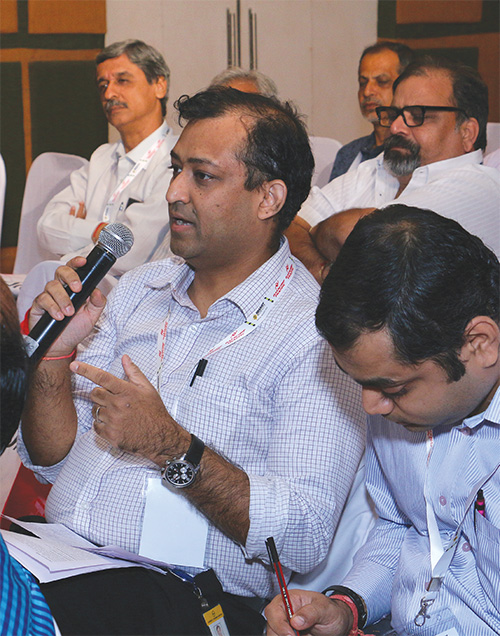Risk Factor
Mahesh then took up the issue of the risk perspective in infrastructure trust. Pointing out that nature of equity returns and debt returns are different, he asked Sekar how would investment trust span the risk and return profiles. He also asked him to explain it keeping the benefit to the road companies in mind.
S ekar was of the view that in-debt investment is an equity investment on the units of the investment trust whether it is real-estate investment trust or infrastructure investment trust. “Those amounts are invested in the equity of the project. Having said that, the risk profile of an infrastructure project is quite significantly different from a normal company that you could possibly invest in, directly through stocks. When you invest in stocks in a country like India, you are basically investing for the growth. A company performs in a market where there are multiple forces at play, whereas infrastructure projects are contractually made in such a way that several aspects are defined already. For example, in a road project, a concession defines the tenure over which you can earn revenue directly from NHAI or from the state or you can go in for toll in certain places. Safeguards are defined well against the competition. Additionally, the InvIT rules also restrict the amount of debt that can be part of the entire structure. The InvITs structure can have only 49% of external debt. There are a few more safeguards in place because of the nature of the projects. Therefore, the cash streams are a lot more stable when compared with a company you would otherwise invest in, in the stock market”.
ekar was of the view that in-debt investment is an equity investment on the units of the investment trust whether it is real-estate investment trust or infrastructure investment trust. “Those amounts are invested in the equity of the project. Having said that, the risk profile of an infrastructure project is quite significantly different from a normal company that you could possibly invest in, directly through stocks. When you invest in stocks in a country like India, you are basically investing for the growth. A company performs in a market where there are multiple forces at play, whereas infrastructure projects are contractually made in such a way that several aspects are defined already. For example, in a road project, a concession defines the tenure over which you can earn revenue directly from NHAI or from the state or you can go in for toll in certain places. Safeguards are defined well against the competition. Additionally, the InvIT rules also restrict the amount of debt that can be part of the entire structure. The InvITs structure can have only 49% of external debt. There are a few more safeguards in place because of the nature of the projects. Therefore, the cash streams are a lot more stable when compared with a company you would otherwise invest in, in the stock market”.
Pointing out the security issues, Sekar said. “It is not a quiet debt because you do not have security that generally debt-owners also have, and additionally you are sub-ordinated as the debt-owners will  get paid first after which the surplus cash flows will be used and 90% of the surplus cash flows have to be paid out to the unit-holders for InvITs. So, the risk profile of the investor lies somewhere in between. Generally and globally, those who invest in InvITs are the people who have time-frame in mind. It is very hard to invest in a company with a 15-year view in mind, but it is a tad easier probably to take a view on how an infrastructure project would perform over a longer period of time or for that matter, even how a real-estate project would perform over a long period. If you have an office complex in BKC area of Mumbai, it is probably easier to view how the rentals would perform over a longer period of time. These asset classes have high amount of upfront investment and long & stable cash units are essentially good for these sorts of investments. Institutional investors like pension & insurance funds require these kind of investments. Also, HNIs and even people who have long investment horizons and are looking for stable income will find these investments profitable. From the return perspective, since the risk is a little higher than that of the debt, you would also expect the return on these InvITs to be higher. There would be a spread on top of the returns one would normally get on other bond investments. However, it will not be higher than the sum of the growth stock”.
get paid first after which the surplus cash flows will be used and 90% of the surplus cash flows have to be paid out to the unit-holders for InvITs. So, the risk profile of the investor lies somewhere in between. Generally and globally, those who invest in InvITs are the people who have time-frame in mind. It is very hard to invest in a company with a 15-year view in mind, but it is a tad easier probably to take a view on how an infrastructure project would perform over a longer period of time or for that matter, even how a real-estate project would perform over a long period. If you have an office complex in BKC area of Mumbai, it is probably easier to view how the rentals would perform over a longer period of time. These asset classes have high amount of upfront investment and long & stable cash units are essentially good for these sorts of investments. Institutional investors like pension & insurance funds require these kind of investments. Also, HNIs and even people who have long investment horizons and are looking for stable income will find these investments profitable. From the return perspective, since the risk is a little higher than that of the debt, you would also expect the return on these InvITs to be higher. There would be a spread on top of the returns one would normally get on other bond investments. However, it will not be higher than the sum of the growth stock”.
Sekar replied in the affirmative to a question from Mahesh who wanted to know if a person buying the units of infrastructure investment trust was essentially looking for regular cash interest pay-outs rather than capital gains.
 TrafficInfraTech Magazine Linking People Places & Progress
TrafficInfraTech Magazine Linking People Places & Progress

